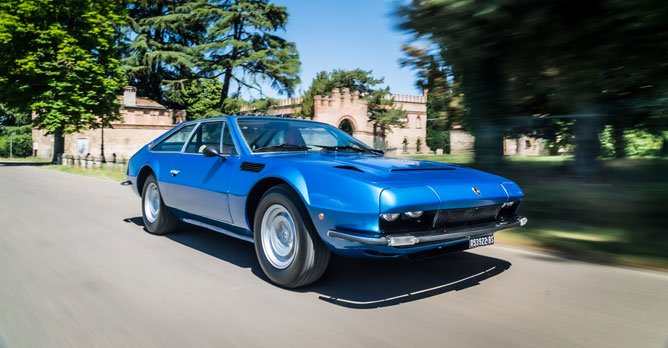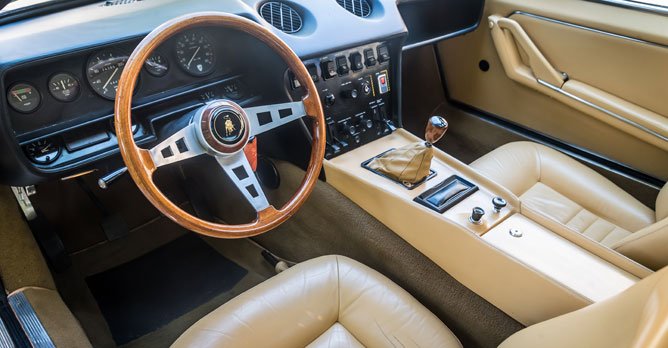Lamborghini celebrates the 50th anniversary of the Jarama GT
16 Nov 2020|1,119 views
The 1970 Geneva Motor Show in Geneva, Switzerland, where the Lamborghini Jarama GT was first presented to the public.
The Jarama, whose name derives from an area north of Madrid famous for breeding fighting bulls, was the latest evolution of the company's 2+2 grand touring sedan concept, with a 4.0-litre V12 front-mounted engine.

The chassis was renewed, with a braking system featuring four large discs, of which the front ones were ventilated, track width widened by 100mm to 1,490mm, and 15-inch Campagnolo magnesium wheels, to enter the new decade in a manner befitting a sporty Lamborghini.
The engine, powered by six double-body Weber 40 DCOE carburettors, was the well-proven Lamborghini V12, with double overhead camshafts per bank, capable of delivering 345bhp for a top speed of 260km/h.
The bodywork of the pre-series units was assembled by Carrozzeria Marazzi of Caronno Pertusella, which had just finished production of the Islero, while the series models would be produced in Carrozzeria Bertone's plant in Grugliasco, Turin. The last 100 units of Jarama produced, in 1972, would be 'hybrid', with body panels produced by Bertone and assembled at Marazzi.

Production of the Jarama, following the 1972 Geneva Motor Show, was expanded with the Jarama GTS version with 360bhp, featuring a transverse air intake on the hood and two air outlets behind the front wheel arches.
Inside, it featured a redesigned dashboard with new instruments, and a different shaping of the front seats to improve the roominess in the back. Also different on the 'S' version were the alloy wheels, which were less elaborate and without the central locking nut.
The Jarama, of which a total of 328 units were produced, is an important model in Lamborghini's history, not only for its beauty - which has not lost its charm over the last 50 years - but because it was the last front-engined grand tourer proposed by the company. From then on, except for the LM002 and Urus, Lamborghinis would only have the rear mid-engine layout.
The 1970 Geneva Motor Show in Geneva, Switzerland, where the Lamborghini Jarama GT was first presented to the public.
The Jarama, whose name derives from an area north of Madrid famous for breeding fighting bulls, was the latest evolution of the company's 2+2 grand touring sedan concept, with a 4.0-litre V12 front-mounted engine.

The chassis was renewed, with a braking system featuring four large discs, of which the front ones were ventilated, track width widened by 100mm to 1,490mm, and 15-inch Campagnolo magnesium wheels, to enter the new decade in a manner befitting a sporty Lamborghini.
The engine, powered by six double-body Weber 40 DCOE carburettors, was the well-proven Lamborghini V12, with double overhead camshafts per bank, capable of delivering 345bhp for a top speed of 260km/h.
The bodywork of the pre-series units was assembled by Carrozzeria Marazzi of Caronno Pertusella, which had just finished production of the Islero, while the series models would be produced in Carrozzeria Bertone's plant in Grugliasco, Turin. The last 100 units of Jarama produced, in 1972, would be 'hybrid', with body panels produced by Bertone and assembled at Marazzi.

Production of the Jarama, following the 1972 Geneva Motor Show, was expanded with the Jarama GTS version with 360bhp, featuring a transverse air intake on the hood and two air outlets behind the front wheel arches.
Inside, it featured a redesigned dashboard with new instruments, and a different shaping of the front seats to improve the roominess in the back. Also different on the 'S' version were the alloy wheels, which were less elaborate and without the central locking nut.
The Jarama, of which a total of 328 units were produced, is an important model in Lamborghini's history, not only for its beauty - which has not lost its charm over the last 50 years - but because it was the last front-engined grand tourer proposed by the company. From then on, except for the LM002 and Urus, Lamborghinis would only have the rear mid-engine layout.
Latest COE Prices
June 2025 | 2nd BIDDING
NEXT TENDER: 09 Jul 2025
CAT A$98,124
CAT B$116,670
CAT C$65,000
CAT E$116,889
View Full Results Thank You For Your Subscription.































